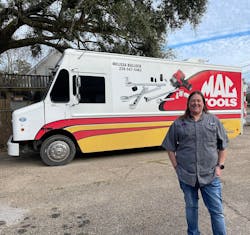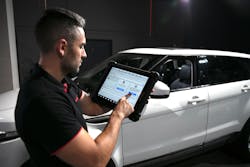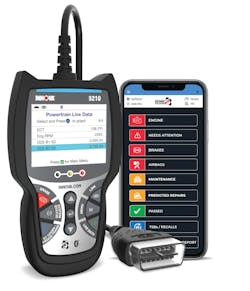Content brought to you by Professional Distributor. To subscribe, click here.
Scan tools can be a bit intimidating. Whether you’ve been in the auto industry for years or are just starting out, this ever-evolving technology can be hard to keep up with. Mac Tools distributor Melissa Bullock has only been a distributor for around a year and a half, and with no background in the automotive industry, she relies heavily on the training provided by Mac.
In order to stay up-to-date on the latest features and functions in scan tools, Bullock noted that aside from reading Professional Distributor magazine, she takes advantage of the weekly Zoom calls that are open to her district to learn more about Mac’s scan tools. Additionally, she utilizes the support from her district manager, attends Mac’s Tool Fair and its variety of training opportunities, and participates in other online training events.
“Mac gives us great support,” Bullock says.
Don’t let her beginner status fool you though, Bullock received Mac Tools’ Diamond status after her first year in the industry. To achieve this, distributors must purchase at least $550,000 worth of tools annually.
Bullock’s route is located in Gulfport, Mississippi where she visits mostly independent auto repair shops and some car dealerships. On the truck, Bullocks keeps the Mac Tools ET9200 Series scan tools in stock as well as some other options from Launch Tech. When it comes to scan tools, Bullock notes that her customers come prepared.
“Basically, the guys really know what they want before they come on the truck,” Bullock says. “Most of them do their research beforehand…so they know what they're looking for when buying one.”
Regardless of how prepared most of her customers are when buying a scan tool, Bullocks is happy to step in and offer whatever help she can if there’s any indecision.
What’s new with scan tools?
With automotive technology rapidly advancing, scan tools must also advance in order to remain useful to technicians. As a mobile tool distributor, your customers will be looking to you for explanations of which scan tools they need to perform repairs regarding this new technology. The following are just a few upcoming functions/features of scan tools to watch out for.
Augmented reality
A major part of many shops’ decisions to buy a certain scan tool can be the support included with the tool. With the rise of remote programming, remote support, and remote scan reports in the aftermarket, many companies such as TOPDON are working to bring their technology to the next level.
Chad Schnitz, vice president, TOPDON USA, notes that TOPDON is upping their remote support for scan tools with augmented reality (AR) glasses.
“The challenge with tech support is we can’t see what the technician is seeing,” Schnitz says. “It’s like playing a game of Pictionary over the phone. The AR glasses allow the technician to plug into the diagnostic tablet, transmitting the camera information from the glasses to the support team. From there the support team can see what the technician is seeing.”
The support team is also able to project images or information onto the AR glasses, as well as circle items, draw, and highlight within a 3-D space for the technician to see. Though not available yet, the AR glasses will help both the technician and the support team to quickly and efficiently get the job done.
EV support
As electric vehicles (EVs) become more prominent, so does the EV diagnostics feature on aftermarket scan tools. But this is a slow-moving process, notes Hiba Anjum, technical support supervisor, Autel.
Many times, if an EV is brought into a shop, there just isn’t the aftermarket support to make the repair, so the vehicle ends up going to a dealership, Anjum explains. Though Autel’s diagnostic tools do support the most popular EV brands, the addition of diagnostics for electric vehicles and the eventual transition away from gas vehicles entirely means that if shops want to be able to service customers with EVs, they’ll need scan tools with those capabilities.
Guided diagnostic services
Having the functionality of guided diagnostic services allows technicians to inform their customers about any additional maintenance their vehicles need with every inspection.
“Scan tool apps and platforms that offer interfaces and reports to provide the technician with clear awareness of scheduled maintenance, predicted diagnostics, fix and topology overviews are important,” says David Rich, technical director, Innova Electronics Corporation. “And those that include customer facing reports that technicians and shops can use to inform the customer, provide transparency and help sell the job for services actually needed.”
Some thoughts on buying
In order to get your customers to purchase a scan tool, you’ll want to understand what considerations they’re taking and maybe some they haven’t even thought of to provide them with the best possible information on what tool/s will work best for their shop.
“Cost of ownership of a scan tool is a big factor, not only the initial purchase, but updates, and warranty,” Schnitz explains. “There are a lot of great scan tools in the market, but how long will it take to get a return on that investment. Just because it is the most expensive doesn’t mean it is right for your shop.”
The same is also true of picking and buying the cheapest scan tool. Anjum notes that shops should be taking price versus functionality into consideration — what are they getting for the price they are paying? This includes paying attention to after-sales support, so tech support, the repair process, and warranty.
“A lot of people don't think, ‘Hey, I might need tech support for something’ and then they find out this company is actually located somewhere else, and they can't even call them,” Anjum says.
Some shops will just purchase the cheapest scan tool they can find and then run into problems later because they didn’t consider everything they would be losing out on for that cheaper price.
Accessories
Though a scan tool can help a technician get started on a repair, there are many accessories or complementary tools, they will need to finish the job.
As Schnitz notes, “A scan tool is only part of the equation.”
Keith Andreasen, tool product manager R&D department, Innova Electronics, Corp. and Schnitz provide a variety of tools your customers may want to consider purchasing in conjunction with a scan tool.
- Oscilloscope
- Digital multimeter
- Harness/connector pin kits
- DLC breakout box for network diagnostics
- Borescope
- Thermal imaging equipment
- Battery tester
- Inspection camera
- Smoke machine
- Lab scope
Tips on selling
1. Demos
As scan tool technology has advanced, manufacturers have made it simple to demo a scan tool with “demo mode” — a feature on most scan tools nowadays.
“If you are demoing a tool, don’t go plugging into random vehicles that you are not familiar with,” Schnitz says. “You want to tell the customer, ‘This tool is so intuitive I’m sure you could figure this out in no time, here… push buttons.’ As a sales professional, you don’t need to know everything about the scan tool, or how to do every function. The more complicated you make it, the harder it is to sell.”
Andreasen also notes that being able to use the tool in a simulated environment (demo mode) allows the technicians to freely test out different features and experience the user interface. This can help them put to rest any worries they had about difficulty using the tool.
Another approach you could take while demonstrating the tool would be to ask what problem the shop is facing and then show the technician how the scan tool can help solve that problem. From there, Anjum notes, the shop will likely be sold on that tool.
2. Keep it simple
Schnitz breaks down selling scan tools into three simple steps:
- Turn the tool on and have it on display.
- Ask the customer, “Did you see my new scan tool? The shops that have purchased this tool love it.”
- Invite them to take a closer look and push some buttons.
3. Focus on important features
Scan tools offer a large range of features and functions, and it can be a bit overwhelming for your customers having you explain them all. Try focusing in on some important features that will most benefit their shop.
One feature you could focus on would be built-in databases and solutions, Andreasen suggests.
“These built-in sources of information allow technicians to immediately ‘test their guess’ when it comes to diagnosing a vehicle versus having to use or pay for separate software,” Andreasen says.
4. Inventory
If you don’t have the inventory your customers are asking for, it’s likely they’ll go to someone else that does.
“Have the inventory on the truck your customers want,” Bullock says. “They want to see how it works before they buy it.”
About the Author
Emily Markham
Editor | PTEN and Professional Distributor
Emily Markham is the editor of Professional Tool & Equipment News (PTEN) and Professional Distributor magazines. She has been writing about the automotive aftermarket since 2019, after graduating from UW-La Crosse with a bachelor's degree in English. During her first three years with EndeavorB2B's Vehicle Service & Repair Group, Markham also wrote for Fleet Maintenance magazine.
Don't miss Markham's next article. Sign up for PTEN or Professional Distributor's weekly newsletter.




